Vintage Gear = ‘Historical Nonsense?’
To get WoodyTone, you almost always have to have vintage gear, or reproductions of vintage gear. That’s just the way it is. Wood, not wood smothered in inch-thick polyester finishes. Tubes, not modeling. Analog, not digital.
There’s a general consensus in the guitar world that older is better: the wood in older guitars has aged; older pickups are warmer; more done by hand instead of by machine. And the wood is what it’s supposed to be, not some Asian variant.
But is older really better? Not really, according to two guys interviewed by PremierGuitar.com recently: Roger Mayer, designer of the Octavia and other pedals; and Hartley Peavey, founder and owner of Peavey. Here’s what they had to say on the subject. Do you agree?
PG: Do you feel like the guitar industry is caught looking backwards more often than not?
Roger Mayer: All I can say is, Don’t you think it’s like that? Of course it is. I mean, you’ve got so much supposedly retro stuff—retro effects, retro guitars, retro bands—it’s sad. It really is sad, because it’s not giving younger people something of their own, is it?
And it’s crazy. Take the stupid concept of buying a guitar that has been aged. That would be like a girl hanging out a pair of ballet shoes in her bedroom that have been aged to look like they’ve been worn by a famous dancer. What’s the point? You’re trying to buy into looking cool. It’s fashion. It’s like buying beaten up jeans.
Hartley Peavey: This fondness for old ways is very interesting to me. For example, on the pickup side of things you have people doing things that make no sense, but they want to do what is “traditional.” For instance, on a single-coil guitar pickup, every coil has a beginning and an end. In the old days they were using sand cast magnets that were literally cast in sand and they were very rough. When they wound the old enamel wire on those pickups they would always use the start as ground, figuring that it if it shorted out against the magnet it wouldn’t be a big deal because it would be close to ground. But the problem is that it left the hotwire all the way out at the end and it wasn’t shielded so it buzzed like crazy, which is ass backwards from the way it ought to be. If you ground the outside, you effectively have shield all around the outside and the hotwire comes off around the inside, but now that we use magnets that are centerless ground and better magnet wire, we won’t have that problem. But they’re still doing it.
Incredibly, there are guitars being made that come with pickups that don’t even use shielded wires, opting instead for all-cotton push back wire. Can you believe it? It’s 2008, but suddenly to them it’s 1947. But you know what? I’m not going to be the one who says anything because these guys claim to be hot stuff and they’re still doing crazy stuff like that.
This company’s big competitor’s two-pickup guitars use that rationale, too. If you put the selector switch in the center position and turn down either of the volume controls, guess what, both volumes go down—well duh! And they’ve been doing it this way since 1952, go figure. It’s this kind of nonsense, historical nonsense, that drives many companies. Rather than doing it a better way, they’re going to cling to an antiquated idea. That’s like voting with paper ballots instead of using today’s technologies. Many players celebrate that voodoo.
Sadly you can’t believe everything you see and very little of what you hear. The problem, I’ve discovered, is that even when you tell people what’s going on, they don’t want to hear it.
The truth is the pickups were “scramble-wound,” and is that a good thing? Well, it depends on who you talk to. Are there people out there who know how to build good pickups? Absolutely, but most of them are nothing but variations on the same tired theme. It’s like guitar players are in a time warp sometimes.
Say a guitar doesn’t balance right—they still build them that way, regardless. I can do that, too, but I just want to do something better.
One more tidbit from Roger Mayer on digital sound:
PG: But isn’t digital where we’re headed?
Mayer: No, not at all. The fact of the matter is, and the thing that never changes, is that the ears are analog. And analog information is continuous; digital isn’t. Digital, if you equate it to a movie, would be like looking at a close-up where the face is in perfect focus and the background is fuzzy and out of focus, as opposed to a wide shot or another shot where the face and all of the background were in perfect focus. There’s obviously more information in the shot where the background is in perfect focus, right?
And the major problem with digital sound, which they can’t get around, is that the majority of the bits are concentrated at the loud parts of the music. In other words, the first 10 or 20 dBs of the music has quite a few bits, but as the music goes down a level, the resolution goes down and down and down, which is the audio equivalent of being out of focus. So that’s why it’s very difficult sometimes to mix digitally on Pro Tools or anything like that, because you just don’t have enough information, you don’t have enough bandwidth. Unless the signals are loud, they get prioritized by loudness, you see?
The actual definition of a signal decreases as it goes down, which is kind of crazy, because the ear has the reverse function. In other words, the Fletcher-Munson curves, which are the equal-loudness curves of the ear— your ear perceives frequency response at different sound pressure levels. And the softer it gets, the more treble it needs, right? Which is exactly the reverse of what digital gives you. So, you know, it’s one of those things.
That doesn’t mean that you can’t take a recording that’s mixed perfectly in analog, and commit it to digital once. Many albums sound fine as a CD, but the actual definition and amount of detail digital provides is not really that great.
Category: Peavey, Roger Mayer














